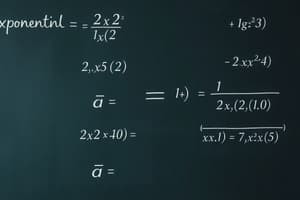Podcast
Questions and Answers
What is the general form of an exponential function?
What is the general form of an exponential function?
- f(x) = a imes b^x (correct)
- f(x) = a / b^x
- f(x) = a + b^x
- f(x) = a - b^x
Which type of logarithm uses base 10?
Which type of logarithm uses base 10?
- Common logarithm (correct)
- Natural logarithm
- Binary logarithm
- Exponential logarithm
What is the effect of using a seed value in random number generation?
What is the effect of using a seed value in random number generation?
- It decreases the randomness of the numbers generated.
- It ensures all generated numbers are unique.
- It enables reproducibility of random sequences. (correct)
- It increases the range of generated numbers.
Which function would you use to round a number down to the nearest integer?
Which function would you use to round a number down to the nearest integer?
What does the max(a, b) function return?
What does the max(a, b) function return?
What is the primary purpose of the pow(base, exponent) function?
What is the primary purpose of the pow(base, exponent) function?
Which property of logarithms states that the logarithm of a product equals the sum of the logarithms?
Which property of logarithms states that the logarithm of a product equals the sum of the logarithms?
Which function would you use to obtain the absolute value of a number?
Which function would you use to obtain the absolute value of a number?
Flashcards are hidden until you start studying
Study Notes
Math Library Methods Study Notes
Exponential Functions
- Definition: Functions of the form ( f(x) = a \cdot b^x ) where ( a ) is a constant, ( b ) is the base (greater than 0), and ( x ) is the exponent.
- Common Functions:
- Natural Exponential Function: ( e^x ) where ( e \approx 2.71828 ).
- Growth/Decay: Used for modeling growth (e.g., population) or decay (e.g., radioactive substances).
Logarithmic Functions
- Definition: The inverse of exponential functions; denoted as ( f(x) = \log_b(a) ) meaning ( b^f(x) = a ).
- Common Types:
- Natural Logarithm: ( \ln(x) ) which uses base ( e ).
- Common Logarithm: ( \log_{10}(x) ) which uses base 10.
- Properties:
- ( \log_b(xy) = \log_b(x) + \log_b(y) )
- ( \log_b(x/y) = \log_b(x) - \log_b(y) )
- ( \log_b(x^k) = k \cdot \log_b(x) )
Random Number Generation
- Purpose: Generate random numbers, often used in simulations and algorithms.
- Common Methods:
- Uniform Distribution: Generates numbers in a specified range, like
Math.random()in many programming languages. - Seed Value: Allows reproducibility of random sequences; the same seed produces the same sequence of numbers.
- Uniform Distribution: Generates numbers in a specified range, like
Rounding and Absolute Functions
- Rounding Functions:
round(x): Rounds ( x ) to the nearest integer.floor(x): Rounds down to the nearest integer.ceil(x): Rounds up to the nearest integer.
- Absolute Function:
abs(x): Returns the absolute value of ( x ), removing any negative sign.
Max, Min, pow, rint, round
max(a, b): Returns the larger of two values ( a ) or ( b ).min(a, b): Returns the smaller of two values ( a ) or ( b ).pow(base, exponent): Raises the base to the power of exponent; equivalent to ( base^{exponent} ).rint(x): Rounds ( x ) to the nearest integer but returns a floating-point value.round(x): Rounds ( x ) to the nearest integer; if halfway, it rounds to the nearest even integer.
These methods and functions are essential for various mathematical computations and programming tasks, providing tools for handling numeric data effectively.
Exponential Functions
- Functions take the form ( f(x) = a \cdot b^x ), where ( a ) is a constant, ( b ) is a positive base, and ( x ) is the exponent.
- The natural exponential function is represented as ( e^x ), approximately equal to 2.71828.
- Exponential functions model growth (e.g., population increase) or decay (e.g., radioactive decay).
Logarithmic Functions
- Logarithmic functions serve as the inverse of exponential functions, expressed as ( f(x) = \log_b(a) ), fulfilling the condition ( b^{f(x)} = a ).
- Natural logarithm uses base ( e ) and is denoted as ( \ln(x) ).
- Common logarithm uses base 10, represented as ( \log_{10}(x) ).
- Logarithmic properties include:
- ( \log_b(xy) = \log_b(x) + \log_b(y) )
- ( \log_b(x/y) = \log_b(x) - \log_b(y) )
- ( \log_b(x^k) = k \cdot \log_b(x) )
Random Number Generation
- Purposeful for generating random values, heavily utilized in simulations and algorithmic processes.
- Uniform distribution methods produce numbers within a specific range; for example,
Math.random()generates a floating-point pseudo-random number. - Seed values enhance reproducibility of random sequences, ensuring the same sequence is generated from the same seed.
Rounding and Absolute Functions
- Rounding functions include:
round(x): Rounds ( x ) to the nearest whole number.floor(x): Truncates to the nearest lower integer.ceil(x): Increases to the nearest higher integer.
- The absolute function is represented as
abs(x), which yields the non-negative value of ( x ).
Max, Min, Power, Rounding Functions
max(a, b)retrieves the greater of two values ( a ) or ( b ).min(a, b)identifies the lesser of two values ( a ) or ( b ).pow(base, exponent)computes ( base^{exponent} ), signifying exponentiation.rint(x)rounds ( x ) to the closest whole number but returns it in floating-point form.round(x)simplifies ( x ) to the nearest integer; if equidistant, it rounds to the nearest even integer.
Summary
These mathematical methods and functions offer crucial tools for quantitative analysis, programming tasks, and numeric data handling, facilitating efficient computation.
Studying That Suits You
Use AI to generate personalized quizzes and flashcards to suit your learning preferences.




